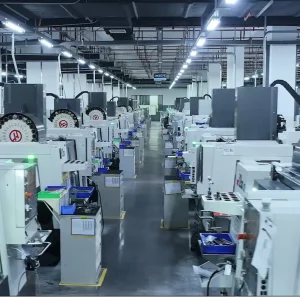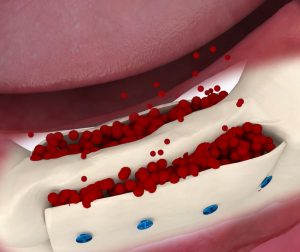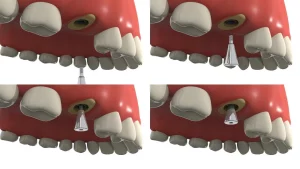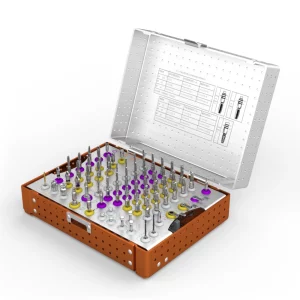In the field of dentistry, implants have become a crucial method for restoring missing teeth. Throughout the entire treatment process, healing abutments play a vital role. The healing abutment is an essential component of dental implant surgery. This article will provide more detailed information about dental implant healing abutments, so please continue reading.
What is a dental implant healing abutment?
The dental implant healing abutment, often referred to as a healing cap or gingival former, is an essential component in dental implant surgery. Made from high-quality titanium alloy, it is specifically designed to guide and promote the healing of the soft and hard tissues around the implant. This device plays a crucial role in the dental implant process, protecting the implant from plaque and food debris while ensuring successful integration with the jawbone and the formation of a natural gum line.
Typically installed on top of the implant, the healing abutment is designed to be slightly wider than the implant itself, helping to shape the ideal gum contour during the healing process. In both single-stage and two-stage implant surgeries, oral surgeons will install the healing abutment at the appropriate time based on the specific circumstances and needs of the patient, supporting and accelerating the recovery and regeneration of the surrounding tissues.
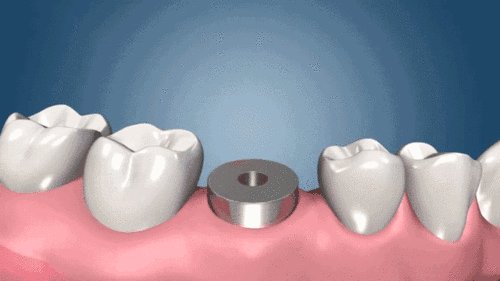
How Does An Implant Healing Abutment Work?
A crucial component of dental implant surgery is the implant healing abutment, whose operation is based on a sophisticated fusion of biological and technical concepts. The healing abutment is securely placed on top of the implant and functions as a connecting bridge when the implant is precisely put into the jawbone. Its pattern is subtly shown above the gum line. This clever design not only gives the gingival tissue clear development guidance, but it also helps it heal around the implant’s edge in a way that will better fit the eventual crown, guaranteeing the aesthetic appeal and naturalness of the finished restoration.
A sterile and healthy healing environment is created for the initial stability and long-term successful integration of the implant by the healing abutment, which also serves as the implant’s guardian by successfully isolating potential threats like bacteria, dental plaque, and food residues in the oral environment. The implant healing abutment is essential to dental implant surgery because it provides a dual protective mechanism that both guides tissue recovery and shields the implant from harm.
Installation of the Healing Abutment
One of the most important procedures in dental implant surgery is the placement of the healing abutment, which is carried out right away after the implant’s successful insertion into the jawbone. The oral surgeon will carefully perform the procedure while under the protection of local anesthetic, making a tiny incision to gently raise the gum tissue and reveal the implant below. The healing abutment is then carefully screwed into the top of the implant using equipment designed for this purpose, ensuring that it is securely in place. In order to produce the best circumstances possible for following gum healing and shaping, the doctor will gently sew the gum tissue back after finishing this phase, making sure that the top of the healing abutment is correctly exposed.

When is the healing abutment placed?
The implant and the healing abutment are inserted simultaneously during the first part of the procedure, creating an effective therapeutic process. The healing abutment is fastened to the implant as soon as it is precisely positioned in the jawbone, serving as a bridge that connects the implant to the eventual crown. The healing abutment maintains the stability and integration of the implant in the jawbone during this period by guiding the gum tissue’s natural healing around its borders. A more advanced connection abutment will take the place of the healing abutment after the healing time has successfully ended and the implant and the jawbone have reached the ideal biological combination. This will provide a strong base for the final crown installation.
The initial implantation and subsequent healing of the implant are separated into two separate phases in the two-stage procedure. To enable a few months of bone integration, the implant is first carefully placed into the jawbone and then momentarily hidden by the gum tissue. In the second stage of the procedure, the doctor will make another incision in the gums to expose the implant and place the healing abutment when the implant and the bone have securely fused. The healing abutment is crucial in this phase for encouraging gum reshaping and healing. Following a time of healing and recuperation, the implant procedure will be concluded with the precise installation of the crown and the removal of the healing abutment.
It is important to note that the healing abutment may be used to considerably minimize the total duration of dental implant surgery, as well as lower the frequency of visits and patient suffering. The patient does not have to endure the agony of a second procedure since the healing abutment and the implant are placed concurrently during the first stage of surgery. But since every patient has a unique oral condition and set of demands, the oral surgeon must assess each case individually and provide help when deciding on a surgical approach and whether to utilize a healing abutment.
Implant Healing Abutment Vs. Cover Screw
In dental implant surgery, the healing abutment and cover screw have separate but significant functions. In order to encourage the gums’ natural shape and provide solid support for the crown installation that follows, the healing abutment is mainly utilized to direct the healing process of the soft and hard tissues around the implant. Usually, it is inserted during one- or two-stage procedures to guarantee that the implant and the jawbone integrate properly.
On the other hand, the cover screw is mostly used in the first protective stage that follows implant placement. It firmly seals the implant’s top, lowering the chance of infection by keeping germs, food particles, and other impurities out of the device. The cover screw is a vital barrier that keeps the implant and jawbone integrated throughout this procedure.
In conclusion, the cover screw prioritizes shielding the implant from contamination to guarantee a seamless healing procedure, while the healing abutment concentrates on encouraging healing and shape in advance of the crown installation. In dental implant surgery, their combined expertise ensures the implant’s proper placement and stability throughout time.
Healing Abutments Should Not Be Reused
To ensure the successful placement and long-term stability of dental implants, patients should avoid reusing healing caps. During the healing process of the implant, it is important to choose the appropriate healing cap based on the dentist’s recommendations and to replace it with a suitable abutment and crown once healing is complete. The reasons for this are as follows:
- Although healing caps can be disinfected, this process cannot restore their original surface characteristics that promote tissue healing. The surfaces of healing caps are specially treated during manufacturing to encourage the growth and attachment of surrounding soft and hard tissues. Once these surface properties are compromised through use, they cannot be regained even with disinfection, which negatively impacts their biocompatibility and healing effectiveness.
- The sterilization process may also adversely affect the initial composition of the titanium material’s surface. Titanium is widely used in dental implants due to its excellent biocompatibility and corrosion resistance. However, excessive disinfection or sterilization can alter the chemical and physical properties of the titanium surface, affecting its interaction with surrounding tissues and diminishing the overall effectiveness of the implant.
- Additionally, reusing healing caps carries the risk of incomplete cleaning. During the healing process, healing caps may come into contact with bacteria, food debris, and other contaminants in the oral cavity. If not thoroughly cleaned, these contaminants may remain on the healing cap, increasing the risk of infection. Furthermore, the cleaning process can also cause physical damage to the healing cap, such as scratches or deformation, which can affect its stability and ability to securely attach to the implant, ultimately impacting the implant’s stability and long-term success.
Wnioski
Dental implant healing abutments are crucial components in dental implant surgery, designed to guide and promote healing of soft and hard tissues around the implant. Made from high-quality titanium alloy, they protect the implant from plaque and food debris, ensuring successful integration with the jawbone and the formation of a natural gum line. The healing abutment is installed on top of the implant, slightly wider than the implant itself, to shape the ideal gum contour during the healing process. It creates a sterile and healthy healing environment, guiding tissue recovery and shielding the implant from harm. The implant and healing abutment are inserted simultaneously during the first stage of the procedure, allowing for a more effective therapeutic process.

